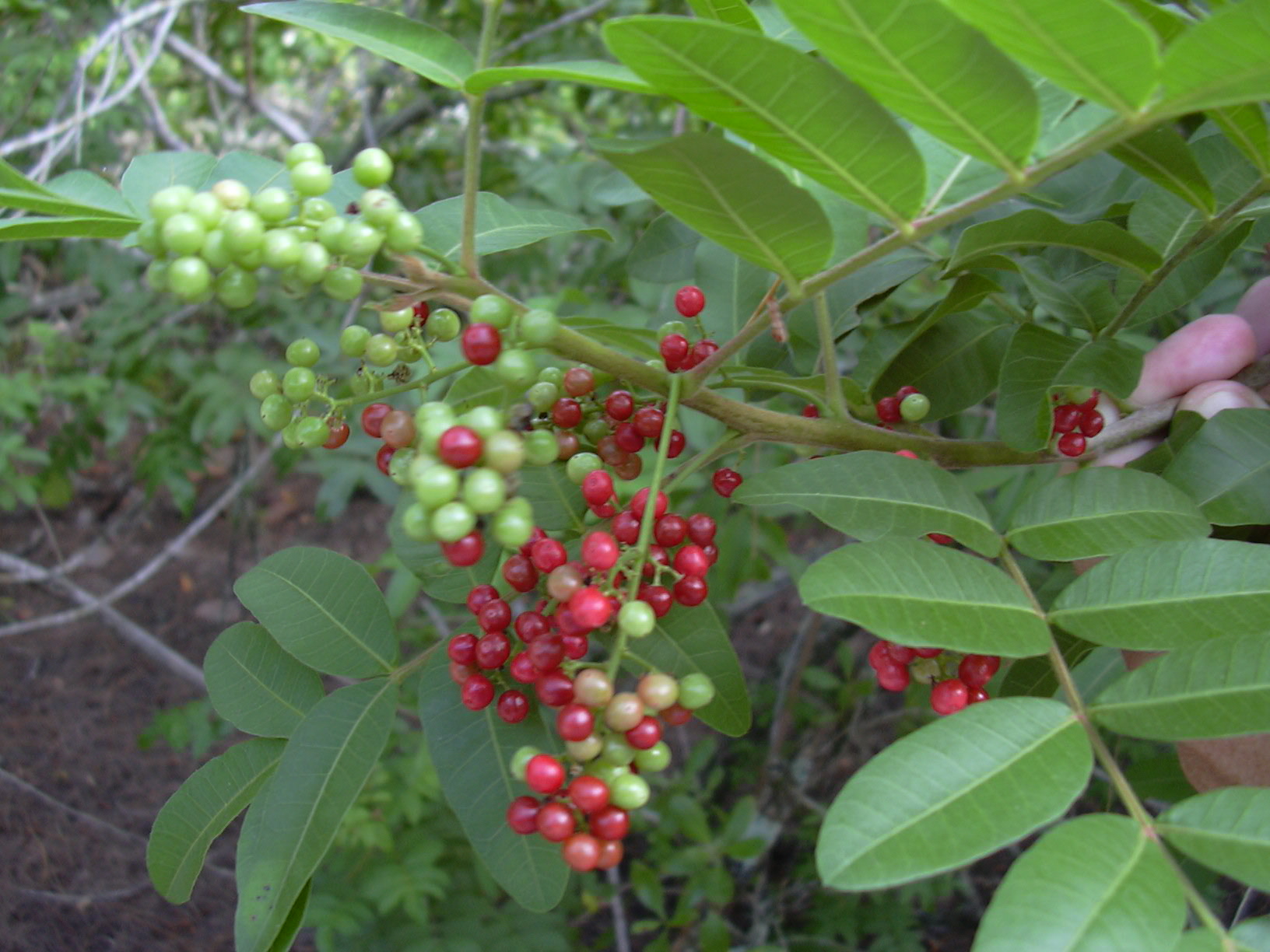- Schinus terebinthifolius
taxobox
name = Brazilian Pepper
regnum =Plantae
unranked_divisio =Angiosperms
unranked_classis =Eudicots
unranked_ordo =Rosids
ordo =Sapindales
familia =Anacardiaceae
genus = "Schinus "
species = "S. terebinthifolius"
binomial = "Schinus terebinthifolius"
binomial_authority = Raddi|Brazilian Pepper ("Schinus terebinthifolius"; also known as Aroeira, Florida holly, and Christmasberry) is a sprawling
shrub or smalltree (7-10 m tall) that is native tosubtropical andtropical South America , in southeasternBrazil , northernArgentina andParaguay . In addition, this plant is found in the following states of Brazil:Alagoas ,Bahia ,Espírito Santo ,Mato Grosso do Sul ,Minas Gerais ,Pernambuco , Paraná,Rio de Janeiro ,Rio Grande do Norte ,Rio Grande do Sul , Santa Catarina, São Paulo, andSergipe . [pt icon [http://www.ipef.br/identificacao/nativas/detalhes.asp?codigo=30 "Schinus terebinthifolius"] at [http://www.ipef.br/ Instituto de Pesquisas e Estudos Florestais] ]Description
The branches can be upright, reclining, or nearly vine-like, all on the same plant. The leaves are alternate, 10-22 cm long, pinnately compound with (3-) 5-15 leaflets; the leaflets are roughly oval (lanceolate to elliptical), 3-6 cm long and 2-3.5 cm broad, and have finely toothed margins, an acute to rounded apex and yellowish veins. The leaf rachis between the leaflets is usually (but not invariably) slightly winged. The plant is dioeceous, with small white
flowers borne profusely in axillary clusters. Thefruit is a small red sphericaldrupe 4-5 mm diameter, carried in dense clusters of hundreds of berries.There are two varieties:
*"Schinus terebinthifolius" var. "acutifolius". Leaves to 22 cm, with 7-15 leaflets; fruit pink.
*"Schinus terebinthifolius" var. "terebinthifolius". Leaves to 17 cm, with 5-13 leaflets; fruit red.Like many other species in the family
Anacardiaceae , Brazilian pepper has aromaticsap that can cause skin reactions (similar to poison-ivy burns) in some sensitive people.Cultivation and uses
Brazilian pepper is an attractive small tree, widely grown as an
ornamental tree in frost-free regions of South America for its decorative foliage and fruit. Although it is not a true pepper ("Piper"), its dried berries are often sold as pink peppercorns. The seeds can be used as aspice if used in moderation, adding a pepper-like taste to food.It has been introduced in
California ,Texas ,Arizona ,Louisiana [cite web | url=http://tncweeds.ucdavis.edu/esadocs/documnts/schiter.pdf | title=Schinus terebinthifolius; Element stewardship abstract] . Planted originally as an ornamental outside of its native range, Brazilian pepper has become widespread and is considered aninvasive species in many subtropical regions with moderate to high rainfall, including parts or all ofAustralia , theBahamas ,Bermuda , southernChina ,Cuba ,Fiji ,French Polynesia ,Guam ,Malta , theMarshall Islands ,Mauritius ,New Caledonia ,New Zealand ,Norfolk Island ,Puerto Rico ,Réunion ,South Africa , and theUnited States (primarilyFlorida andHawaii ). In drier areas, such asIsrael and southernCalifornia , it is also grown but has not generally proved invasive.Brazilian Pepper is hard to control because it sends up root suckers and new shoots if the trunk is cut, and trees produce abundant seeds that are dispersed by birds.
"Florida Holly" was introduced to Florida by at latest 1891, probably earlier (Gogue et al. 1974), where it has spread rapidly, replacing native plants, with thousands of acres occupied. It is especially suited to colonizing disturbed sites and can grow in both wet and dry conditions. Its growth habit allows it to climb over understory trees and invade mature canopies, forming thickets that choke out most other plants. The species is now legally prohibited from sale, transport, or planting in the United States, where it is classified as a Category I pest by the Exotic Pest Plant Council (EPPC) [ [http://www.dep.state.fl.us/lands/invaspec/4thlevpgs/WGFloridakeys.htm Florida Department of Environmental Protection] ] . To keep the plant from spreading into native plant communities and displacing them, local regulations and environmental guidelines require eradication of Brazilian Pepper wherever possible.
References
Notes
Works cited
* Gogue, G. J., Hurst, C. J., & Bancroft, L. 1974. Growth inhibition by Schinus terebinthifolius. "HortScience" 9 (3): 301.
External links
* [http://www.dep.state.fl.us/mainpage/default.htm Florida Department of Environmental Protection]
* [http://www.issg.org/database/species/distribution.asp?si=22&fr=1&sts= Global Invasive Species Database: "Schinus terebinthifolius"]
* [http://tncweeds.ucdavis.edu/esadocs/documnts/schiter.html US Nature Conservancy: "Schinus terebinthifolius"]
Wikimedia Foundation. 2010.
